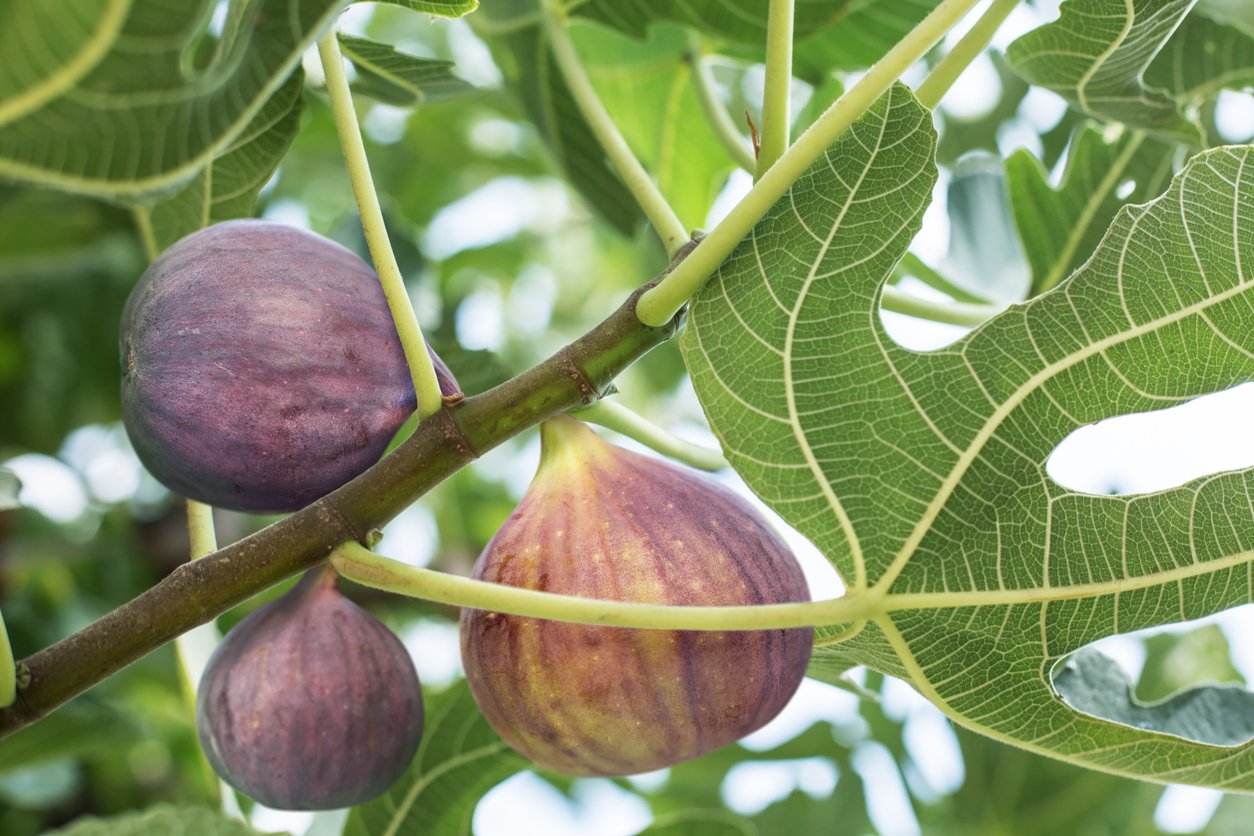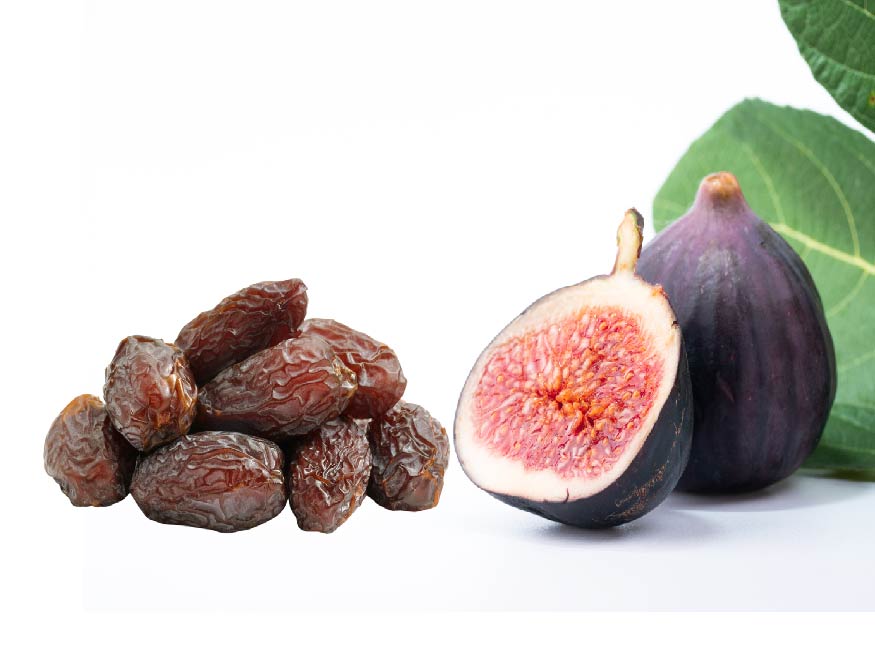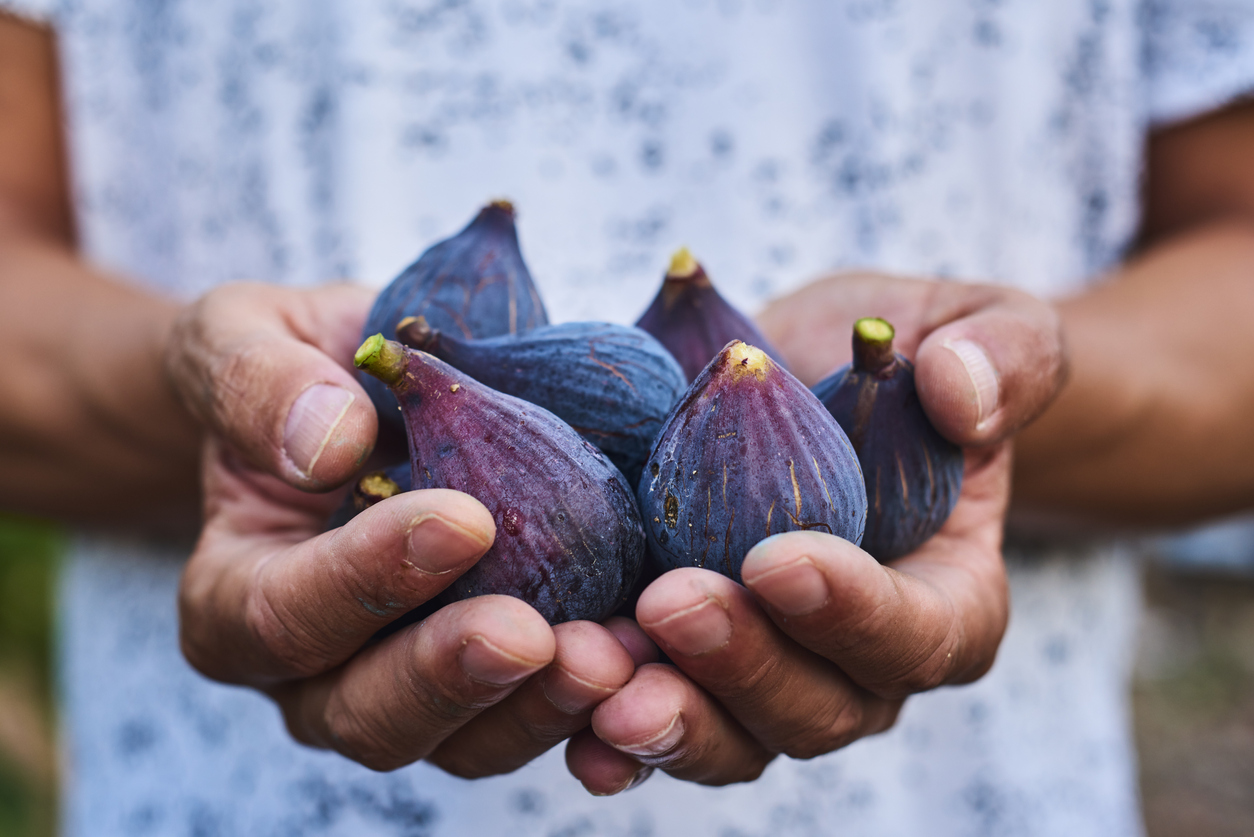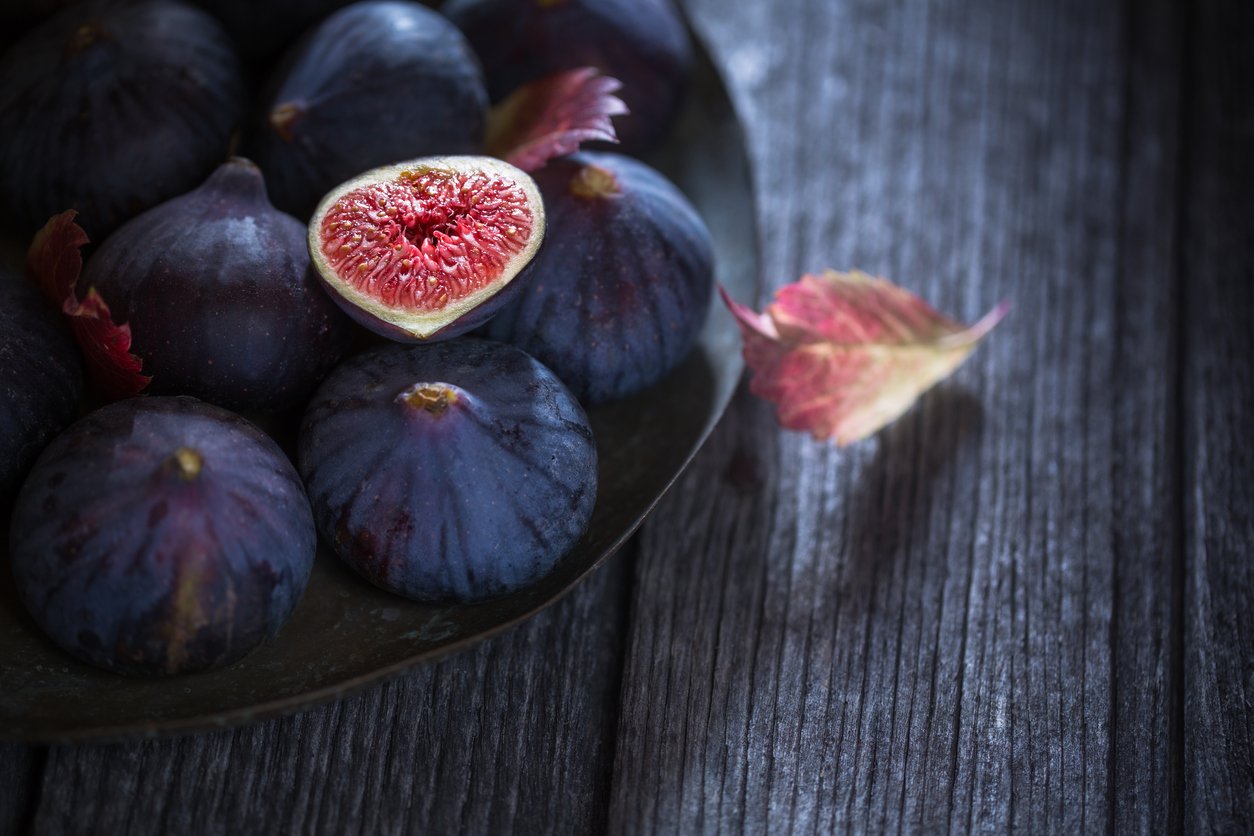Have you ever had an experience where you thought you knew someone well, and then they turned around and totally surprised you? Like, the quiet guy in your yoga class turns out to be a world-famous YouTuber, or your cranky aunt used to be a trapeze artist?
Well, that’s the experience I just had researching this article about figs. I thought I knew a lot about this yummy fruit until I started digging into the topic. Spoiler alert: They’re not even fruits! And when I discovered how they get pollinated — that’s a drama worthy of a Game of Thrones episode!
But aside from their storied pollination method, figs have a lot to offer. In addition to being a delicious food, figs have also traditionally been used for healing and for some very practical purposes. For countless generations, people around the world have made poultices from fresh or dried figs, fig leaves, and fig wines. Fig stems and leaves contain latex. And, of course, fig leaves have served as, well, strategically placed garments since the Garden of Eden (at least according to some Renaissance painters).
You can also find mention of figs in both the Bible and the Quran. Biblical writers often use figs as metaphors for the physical and spiritual health of the people, with phrases like “everyone under their own vine and under their own fig tree” depicting a time of peace and prosperity. The prophet Muhammad is said to have told his followers to eat the fig “as it cures various diseases.”
In this article, we’re going to focus on the culinary uses of figs. We’ll explore what figs are, how they taste (and how they differ from dates), the nutritional value of fresh vs dried, and their health benefits and downsides.
We’ll also look at how they get pollinated (so dramatic!), and if that process might render figs unfit for a vegan diet.
What Are Figs?

Fig trees (or Ficus carica) are native to the Mediterranean region and were one of the first plants to be cultivated.
Figs are members of the mulberry family, which, contrary to the nursery rhyme, is mostly populated by trees, not bushes to “go ‘round and ‘round.” (Other family members include the banyan, breadfruit, jackfruit, and Osage orange.)
A fig fruit (which, again, is not really a fruit) is known as a syconium. According to the Ecological Society of America, “a fig is not actually a fruit; it is an inflorescence — a cluster of many flowers and seeds contained inside a bulbous stem.” And as we’ll see, it’s that structure that makes its pollination so darn interesting.
Because the fig flower is arranged so unusually, the seeds — which are actually the ovaries of the fig — can’t be pollinated by ordinary flying insects like bees, moths, and butterflies. Instead, it requires a pollinator with the skills of a safecracker who can operate in dark, confined quarters (more on that later).
Types of Figs
There are more than 750 different varieties of fig. Some of the types you’re likely to encounter include Adriatic, Black Mission, Turkish/Brown Turkey, Calimyrna, Kadota, Celeste, and Tiger. Different types have different flavor profiles, and feature in a variety of dishes, from sweet desserts to more savory fare.
The most common dried figs in the US are Black Mission and Golden, both of which are grown in California.
Figs are light green as they grow. They may remain green or change color as they ripen, ranging from yellow to brown to dark purple, depending on the cultivar.
The Differences Between Figs and Dates

Figs and dates are two very different foods that people sometimes get confused with one another, kind of like the actors who play Harry Potter and Frodo. Here are some key differences. Frodo didn’t go to Hogwarts — oops, I mean, here are some key differences between figs and dates.
While figs originated in the Mediterranean region, dates are native to several geographical locations, including North America. Figs grow on trees, while dates are the fruits of palm trees, which are technically grasses and not trees (this is such a genus-bending article!).
Furthermore, figs grow on fig tree branches, while dates grow in clusters on offshoots from the main trunk of the palm tree. Dates contain a single pit, while figs have many small edible seeds.
When it comes to eating the fruits, they’re also quite different. Figs have three times the amount of water as dates, which also makes them much lower in calories (about four times lower, if you’re counting). So dates are a much more concentrated source of carbohydrates, mostly in the form of simple sugars. Dates are also richer sources of some minerals, such as calcium and potassium.
Nutrients in Figs
The good news is figs deliver a lot of essential nutrients. The predominant macronutrient (the one that provides calories) is carbohydrates, but they’re also rich in some vitamins and organic acids. As whole plant foods, they also provide important dietary fiber.
According to the US National Nutrient Database, two medium raw figs contain roughly 3 grams of fiber. Doing the math, this means that if you ate just 8 figs a day and nothing else, you’d still get about half as much fiber as the average US resident consumes in a day. (To be clear, I am NOT recommending the “8 Fig a Day Diet,” although someone could probably write a best-selling diet book with that title.)
However, some researchers have measured much greater amounts of fiber in different fig cultivars. According to the American Botanical Council, two fresh or 4–5 dried figs provide a whopping 12 grams of fiber.
So we have credible authorities telling us that two figs provide 3 grams of fiber, while others say the correct figure is 12 grams of fiber. It reminds me of the old saying, “A person with one watch knows what time it is. A person with two watches… is never quite sure.” So for now, let’s just say that figs are high (potentially very high!) in fiber, and leave it to the good folks at the US National Nutrient Database and the American Botanical Council to duke it out on the details.
Figs are a good source of many bioactive phytonutrients, too, including flavonoids, phenolic acids, carotenoids, and tocopherols.
(Here’s a fun article all about flavonoids, which starts with a weird story about a bunch of soldiers trying to cross a bridge.)
They’re also solid sources of potassium, calcium, sodium, magnesium, and phosphorus. What’s more, figs provide essential trace elements, including iron, manganese, zinc, and copper.
You’ll get the most nutrients if you don’t peel your figs; the highest concentrations of phytonutrients are in their skin. And darker fig varieties contain more polyphenols and antioxidant power than lighter ones.
Figs also lose some phytonutrients when dried. Studies show a loss of 29% to as much as 86% of the polyphenol content when figs are dried.
Health Benefits of Figs

In the Middle East and Mediterranean regions, figs have long been revered for their contributions to human health and longevity. The fruit, leaves, latex, bark, and roots of fig trees have been used to treat gastrointestinal, respiratory, inflammatory, and cardiovascular disorders, as well as ulcerative diseases and cancers. The various parts of the fig tree possess a wide variety of properties; they can help you poop, relax muscle spasms, fight viruses and bacteria, bring down high blood sugar, and even help your body expel parasites.
And modern scientific research has only added to our understanding of the power of figs to promote health.
Figs and Gut Health
When patients with irritable bowel syndrome add figs to their diet, they often experience decreased symptom occurrence and severity. A 2019 study gave IBS patients 90 grams of dried figs per day for four months. Compared to controls who didn’t get anything, the fig-enhanced group had reduced frequency of pain, less intestinal distention, more frequent pooping, and softer stools. Unsurprisingly, they also reported “a significant increase in quality of life.”
In a 2018 animal study, rats with induced ulcerative colitis were fed a liquid extract containing figs. The treatment had a natural laxative effect but did not lead to diarrhea, and it improved their gastrointestinal functioning. (Our view on the use of animals in medical research is here.)
Figs and Diabetes

Figs (and fig leaves) can also be deployed to treat diabetes. A 1998 study found that people with type 1 diabetes who drank tea made from fig leaves were able to lower their blood sugar immediately following meals. And a 2019 study showed that a fig leaf decoction was able to lower blood sugar in people with type 2 diabetes by about half as much as the drug metformin (after two months of treatment).
It’s not just the leaves, though — fig fruits contain a compound called abscisic acid (which should definitely be included in spelling bees) that has been shown to reduce blood sugar levels after meals.
Figs and Cognitive Decline
Studies with experimental animals have shown that figs may help us stay sharp and avoid or delay cognitive decline. One animal study compared the effects of a diet that included figs to a fig-free diet in mice that were genetically engineered to develop Alzheimer’s disease. The mice who ate figs did better on memory tests, displayed fewer anxiety behaviors, learned new things more quickly and fully, and had better motor coordination. Furthermore, the fig-eating mice had lower levels of the toxic amyloid beta proteins that are associated with the development of Alzheimer’s disease.
Are Figs Vegan?

This may seem like an odd question, but remember that Game of Thrones reference from earlier? It turns out, fig tree pollination is a bit controversial.
You see, there are two types of fig trees: wild and cultivated. And wild-growing fig trees require pollination to bear fruit. The critters that have volunteered for the job are fig wasps, a term that describes any of several hundred different, mosquito-like tiny creatures from the Agaonidae family. Each species of fig wasp pollinates only one variety of fig.
Basically, here’s how it works.
A female wasp, loaded with pollen, flies to an unripe fig and burrows into its center to deposit her eggs. While she’s doing this, two things happen. One, she spreads her pollen onto the female flowers. And two, the effort of fighting her way through the flower strips her of her wings.
Now the fig goes to work, building structures called galls over the wasp eggs and producing seeds in the flowers that don’t contain the eggs. Meanwhile, the mama wasp dies, whereupon her exoskeleton is dissolved by figgy enzymes. (Cue the emotional orchestral music.)
The heroic male wasps hatch first, and travel around the syconium fertilizing their sisters who are still pupating in their galls. (This is definitely HBO-worthy stuff!) Then they dig holes through which the fertilized females can escape with their wings intact. Once the females hatch, they fly off to repeat the process, leaving the males to die in the maturing fig.
Pretty intense family drama, huh?
As a result, some vegans do not eat figs because they don’t want to consume dead wasps, and also because animals died as part of the process that produced them. However, there’s good news if you want to adhere to a vegan diet and still enjoy delicious figginess.
First, the wasps are completely dissolved by the plant enzymes, so you are not likely to encounter a dead insect in your fig. And second, almost all figs produced and sold in the US are of the cultivated variety and are self-pollinating. This means they don’t need the sacrificial services of the fig wasps, and are considered vegan-friendly.
Fig Downsides
Aside from the fig wasp controversy, there are some other things about figs to consider. For one, some people may have to avoid them because of allergic reactions, including oral allergy syndrome. The latex in the plant may also be a source of irritation and allergy, especially if you’re harvesting figs.
Also dried (but not fresh) figs are high in compounds called salicylates, which may cause swelling, itching, hives, worsened asthma, and food intolerance symptoms in people who are sensitive to them.
The other thing about figs is that it takes a lot of water to grow them. Although they’re not as needy as some other crops like citrus, almonds, alfalfa, and pasture grasses, in places straining under multiyear droughts, such as California and Spain, this can be a problem.
On the other hand, fig trees, like almond trees, are drought tolerant, so they can be a good solution in some cases. While they may not bear fruit during times of drought, they can survive until the rains return. There are several strategies growers can implement, including mulching, thinning fruit to help the remaining fruit develop fully, and protecting trees with shade cloth during the hottest parts of the day.
One other challenge with growing figs, and I say this from personal experience, is that for some reason gophers love their roots. So if you aim to grow a fig tree, it may be wise to place a wire gopher barrier in the planting hole to protect the root ball from those sharp little teeth.
Overall, growing figs appear to be a net positive for the environment. Offsetting their water needs and their moderate carbon footprint, they don’t require heavy use of pesticides. Plus, fig trees sequester carbon in their biomass, keeping it out of the air and not contributing to the climate crisis.
We Dig Figs!

As you’ve probably gathered by now, figs are pretty unique! Their biology is fascinating, and the saga of their pollination is dramatic, to say the least. They also offer a wide range of essential nutrients and health benefits. From their versatile culinary uses to their historical uses as healing agents, figs have proven themselves valuable partners to the humans who have loved, cultivated, and revered them for millennia.
If you’re inspired to add more figgy goodness to your diet, we’ve got you covered: Here’s an article all about different ways of preparing and eating figs.
Tell us in the comments:
-
What’s the most surprising fig fact you got from this article?
-
Can you find fresh figs where you live? If so, what do you do with them?
-
Have you ever planted a fig tree?
Featured Image: iStock.com/SGAPhoto

